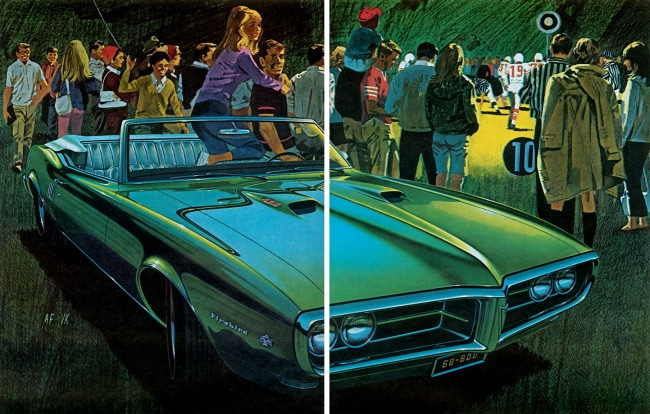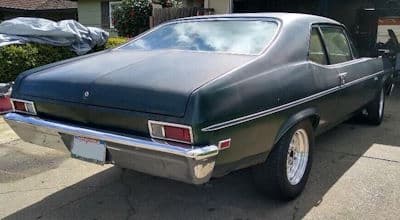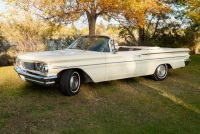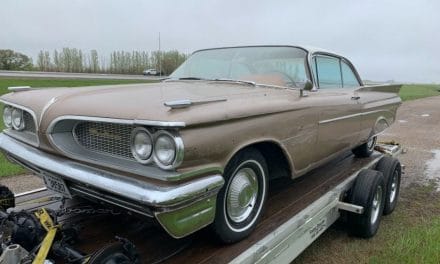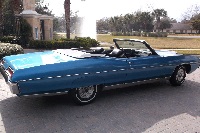Here’s something very cool – a commercial from 1968 about the Pontiac Firebird Convertible!
I wonder if this Firebird has the 350 V8 with automatic transmission, power steering and power brakes?
I’ll bet it has the power top for sure.
These were the best-looking Firebirds, IMHO.
I do hope you enjoy this video!
Find Pontiac Firebird Convertibles for sale HERE!
Pontiac Firebird Convertible – A Little History
The Pontiac Firebird, introduced in 1967, is an iconic American muscle car that has captured the imagination of automobile enthusiasts for decades. Developed by the Pontiac division of General Motors, it was designed to compete in the pony car market, a segment dominated by the Ford Mustang and later, the Chevrolet Camaro. The Firebird shared a platform with the Camaro, yet it distinguished itself with unique styling and engineering choices that reflected Pontiac’s performance-oriented brand image. This exploration into the early years of the Pontiac Firebird will cover its inception, design, performance, and the variations that marked its evolution in the late 1960s and early 1970s.
Inception and Development
The Pontiac Firebird was conceived in a period of intense competition in the American auto industry, with manufacturers vying for dominance in the emerging youth market. The success of the Ford Mustang, introduced in 1964, had established the pony car as a lucrative segment. General Motors responded with two models: the Chevrolet Camaro and the Pontiac Firebird. While both cars were based on the same F-body platform, Pontiac aimed to differentiate the Firebird with distinctive styling and a focus on performance.
Design and Styling
The first-generation Firebird, spanning from 1967 to 1969, showcased a blend of muscular contours and sports car aesthetics. It featured a characteristic long hood and short rear deck, a Coke-bottle silhouette, and a split front grille that became a Pontiac trademark. The Firebird’s design was further accentuated by its “bird” emblem, a stylized phoenix, which symbolized rebirth and strength.
Interior design focused on comfort and sportiness, with bucket seats, a floor-mounted shifter, and a full array of gauges. The Firebird also offered a range of customization options, including deluxe interiors, additional instrumentation, and various exterior trims, allowing buyers to tailor the car to their preferences.
Performance
From its launch, the Firebird was available with an impressive range of engine options, catering to a wide spectrum of performance desires. The lineup included:
- A base model with a 230 cubic inch (3.8-liter) OHC inline-six, a novel offering for a pony car, providing a balance between performance and fuel economy.
- A series of V8 engines, starting from a 326 cubic inch (5.3-liter) option to the more powerful 400 cubic inch (6.6-liter) V8, which was the top-of-the-line engine choice for those seeking maximum performance. This 400 V8 was notable for its high torque output and was available in several states of tune, including a Ram Air version with functional hood scoops and higher horsepower ratings.
These powerplants were paired with a choice of transmission options, including a standard three-speed manual, a four-speed manual, and a two-speed automatic. Performance-focused models could be equipped with features such as a limited-slip differential, heavy-duty suspension, and power-assisted brakes, enhancing the Firebird’s driving dynamics.
Variants and Special Editions
Throughout its first generation, the Firebird lineup expanded to include several notable variants:
- Firebird Sprint: Featured the OHC 6-cylinder engine with a four-barrel carburetor, offering a mix of sportiness and fuel efficiency.
- Firebird 326 and 326 HO (High Output): Positioned as entry-level V8 options, providing a step up in performance from the base inline-six.
- Firebird 400: The performance flagship, equipped with the 400 cubic inch V8, and available with Ram Air options for enhanced power.
- Firebird Trans Am: Introduced in 1969, the Trans Am variant became the epitome of Firebird’s performance aspirations. Named after the Trans-American racing series, it featured distinctive styling, including a special white and blue paint scheme, and came equipped with the high-performance Ram Air engines, making it a rare and sought-after model.
Conclusion
The early Pontiac Firebird models played a significant role in defining the American muscle car era. Through its blend of distinctive styling, a wide range of powertrain options, and a commitment to performance, the Firebird established itself as a key player in the pony car segment. It not only competed successfully with its rivals but also forged a lasting legacy, influencing the development of performance cars for years to come. The Firebird’s evolution during its early years reflects a period of automotive innovation and cultural significance, capturing the spirit of an era when speed and style ruled the American roads.

